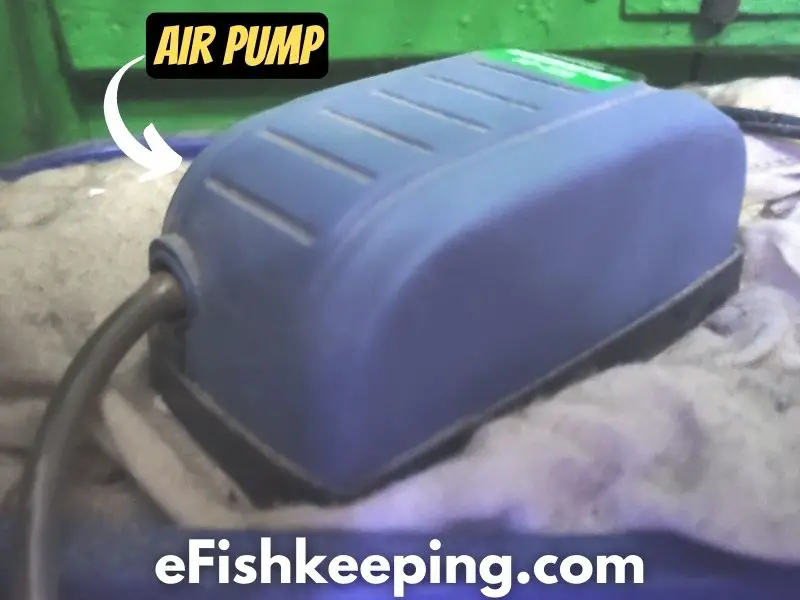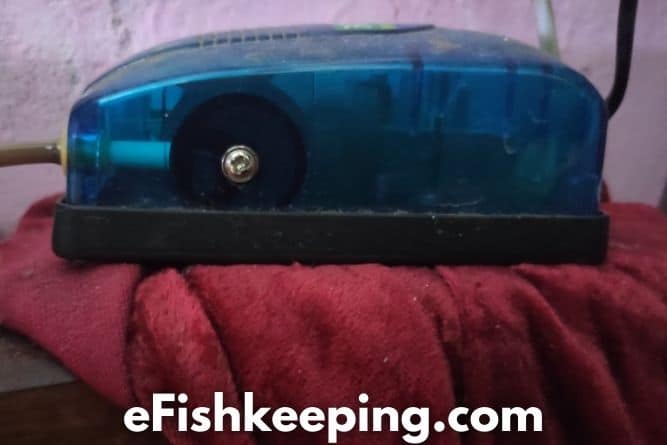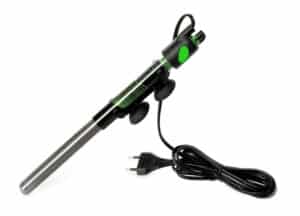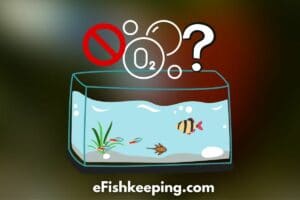UPDATE: If you came here looking for “where to place air stone in aquarium,” please click here to read the detailed article on it.
Aquarium air pump, if you have got them for the first or even if you already have it. A question that may come to your mind is, where should an aquarium air pump be placed?
The pump itself (the mechanical part) is placed outside the aquarium, the part that is submerged is the tube and whatever is fitted in its outlet (porous stone, sponge filter, etc.). The best place to position the mechanical part of the pump is above the surface of the aquarium water level, due to safety in case of malfunction.
What Is An Air Pump For Aquarium?

The air pump is a kind of pump, that generates a flow of air bubbles through a tube, causing the water in the aquarium to move to the surface. Thus, preventing the formation of stagnant areas and facilitating gas exchange with the external environment.
These gases are (mainly) oxygen, nitrogen, and carbon dioxide. It has the function of moving the water column, allowing greater exchange of gases between the aquarium water and the atmosphere.
However, it is not capable of removing impurities from the water or, transforming ammonia into nitrites and nitrates.
In addition to its complementary use to maintain good health in the tank, this type of pump is also used for ornamental purposes, creating effects and bubble curtains.
It is very easy to understand why to inject air into the system, its advantage is simply to cause a disturbance in the water, thus breaking the surface tension, which (due to osmosis) promotes gas exchange, leading to CO² molecules (and other various gases present in our aquariums) to the outside, and the O² (and other atmospheric gases) into the tank. This will promote beneficial gas renewal to the system.
In addition, the physical movement of air bubbles within the water column will “pull” along the water, creating a certain “current” and causing a constant flow of water inside the aquarium, where all the areas will receive renewed water through the gas exchanges promoted on the surface.
Read Also: Do Bettas Need Air Pump?
Can Air Pump Go Below Tank?
Positioning the pump above the water level prevents that in the event of a power outage, or malfunction (failure or tube clogging), the water returns through the air tube, due to gravity and capillarity, which will likely damage your equipment, in addition to the risk of drain out the water of your tank, which is not good, potentially causing damage.
If positioned below the water level and a failure occurs, the tendency is for the pressure to return by gravity into the pipe and, consequently, into the pump (which will likely cause irreparable damage).
Sometimes the aquarist with limited space has to place his pump somewhere below the water level of the aquarium, when this occurs, in order to protect the system and equipment, we can make use of a valve called “check valve“.
What Is A Check Valve And Is It Necessary?
It is a type of valve that works with fluids. Within a failure in the pump or the detachment of the tube, the water pressure can cause a siphon action, just similar to how you perform a water change.

Check This Here (on Amazon)
The non-return valve is an indispensable safety item for your aquarium air system as it prevents water from returning through the hose and entering the air compressor.
An example is when there is a power outage and the aquarium water ends up coming back through the hose and without this valve it enters the air outlet, flooding all the equipment, which can cause a serious accident in your house.
You can watch this video from Trafish Aquatics YouTube Channel to know about check valves – how they work.
This valve prevents the return of liquid through the silicone tube, in case of malfunction or sudden stop, allowing only one direction of flow within the conduction, interrupting what we call negative pressure, that is, the return of the fluid through the same inlet location. It is a small fitting that sits inline on your airline or any other aquarium tubing.
Read: How Long Should You Run An Air Pump And How Long Does It Last?
How Do You Use An Air Pump In A Fish Tank?
It is very easy to proceed with the assembly of your equipment, once you have chosen the model of pump, hoses, and outlet to be used, just assemble them.
- Connect the silicone pipe to the air outlet of the pump in question.
- Cut the hoses to the required size and connect the valves of your choice, preferably, always use the check valve as a safety item and the air regulation valve, preferably leave them immersed.
- Then connect the continuation of the hose and, at the end of this, the outlet, being the sponge filter or the porous stone or the chosen decoration, this last part must be immersed.
You can also watch this video from Fishaholic YouTube Channel on how to set up an air pump and air stone in an aquarium.
Final Thoughts
In short, the air pump “pushes” atmospheric air into the water column inside the aquarium. Thus, injecting air into the system, breaking the surface tension, and also helping and maintaining circulation, which prevents it from creating dead zones (zones without oxygen) inside the tank, help in the oxygenation of water and gas exchange on the surface.
And regarding the placement, it is best to place the air pump near the top of the aquarium water level.
So I hope now your all doubts related to the aquarium air pump are cleared. Please share this article if you found it helpful. And if interested, you can visit my YouTube Channel eFishkeeping.
Read Next:
That’s it! Thanks, enjoy fishkeeping 🙂
References:
Aquarium Coop – Aquarium Air Pump
Aqua-Fish.net – Aquarium Air Stones
Tropical Fish Care Guides – Fish Tank Air Pump
Hi! I’m Praveen Ghoshal, the founder of eFishkeeping.com. Inspired by my Dad, I got interested in fishkeeping when I was a kid. Since then, I have been involved with this hobby. Currently, I have 3 fish tanks at our home, and I enjoy this hobby with my full family. Read more about me here.







